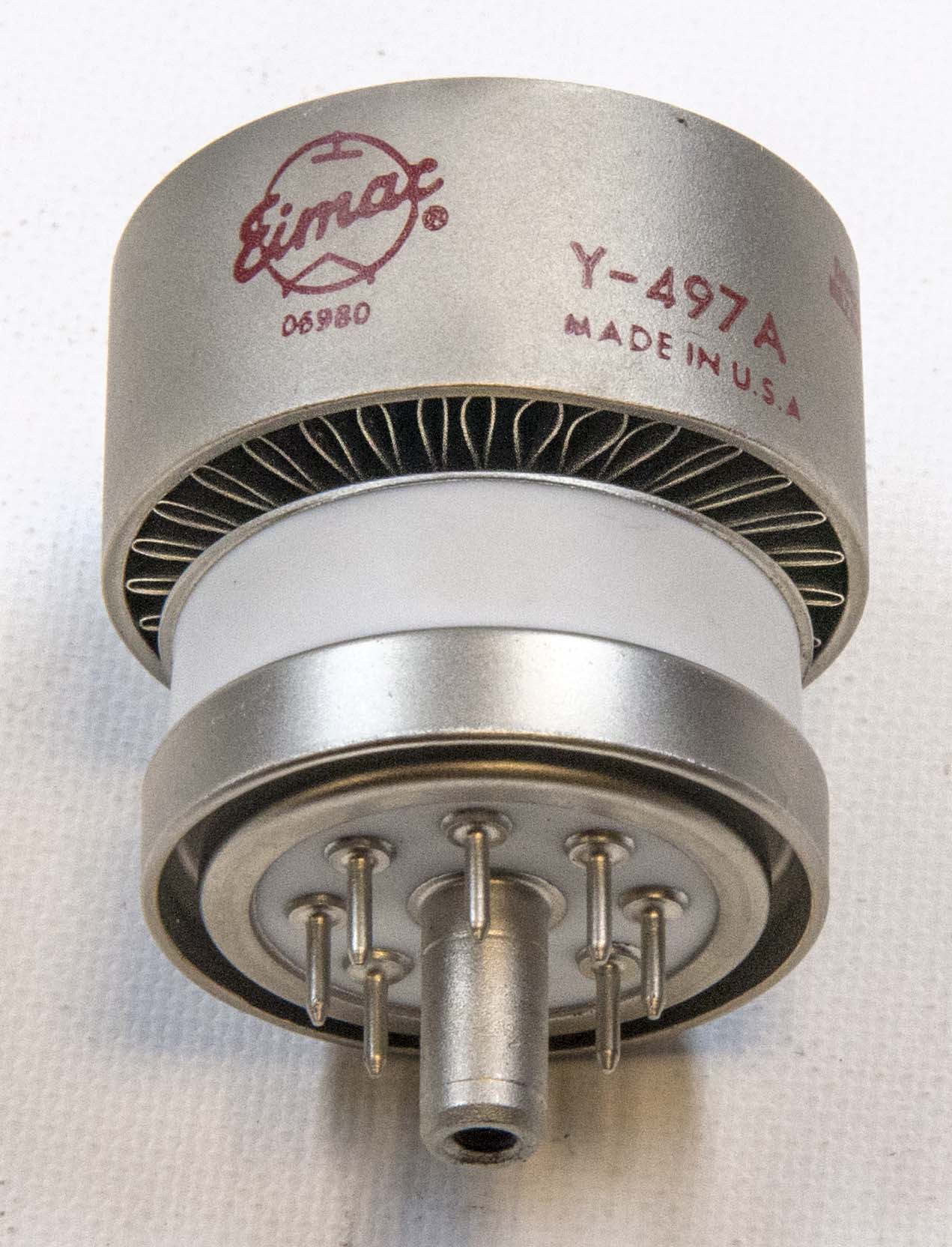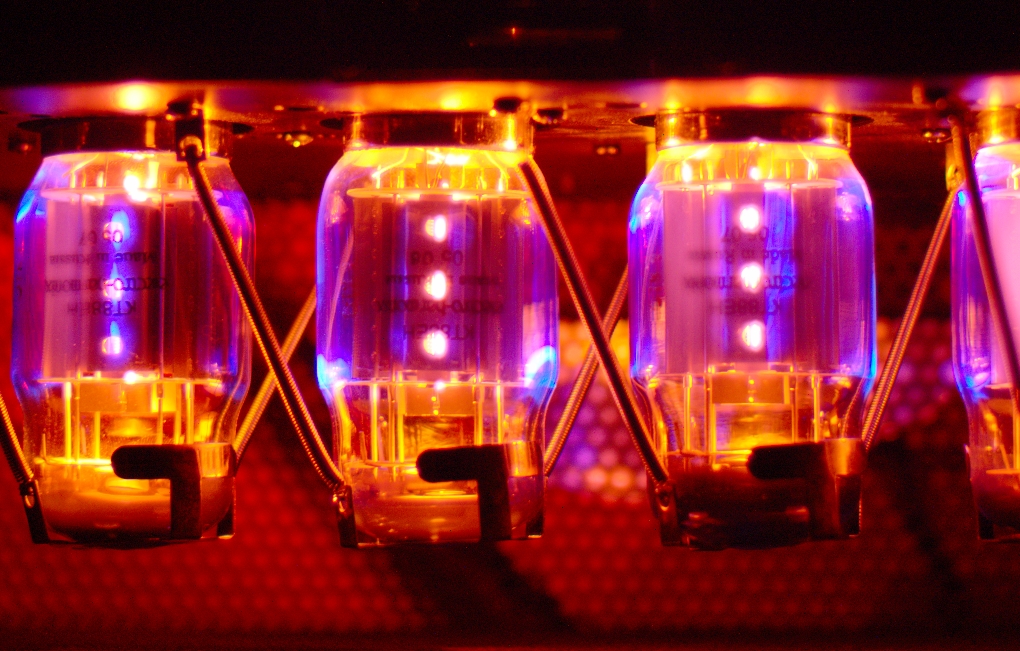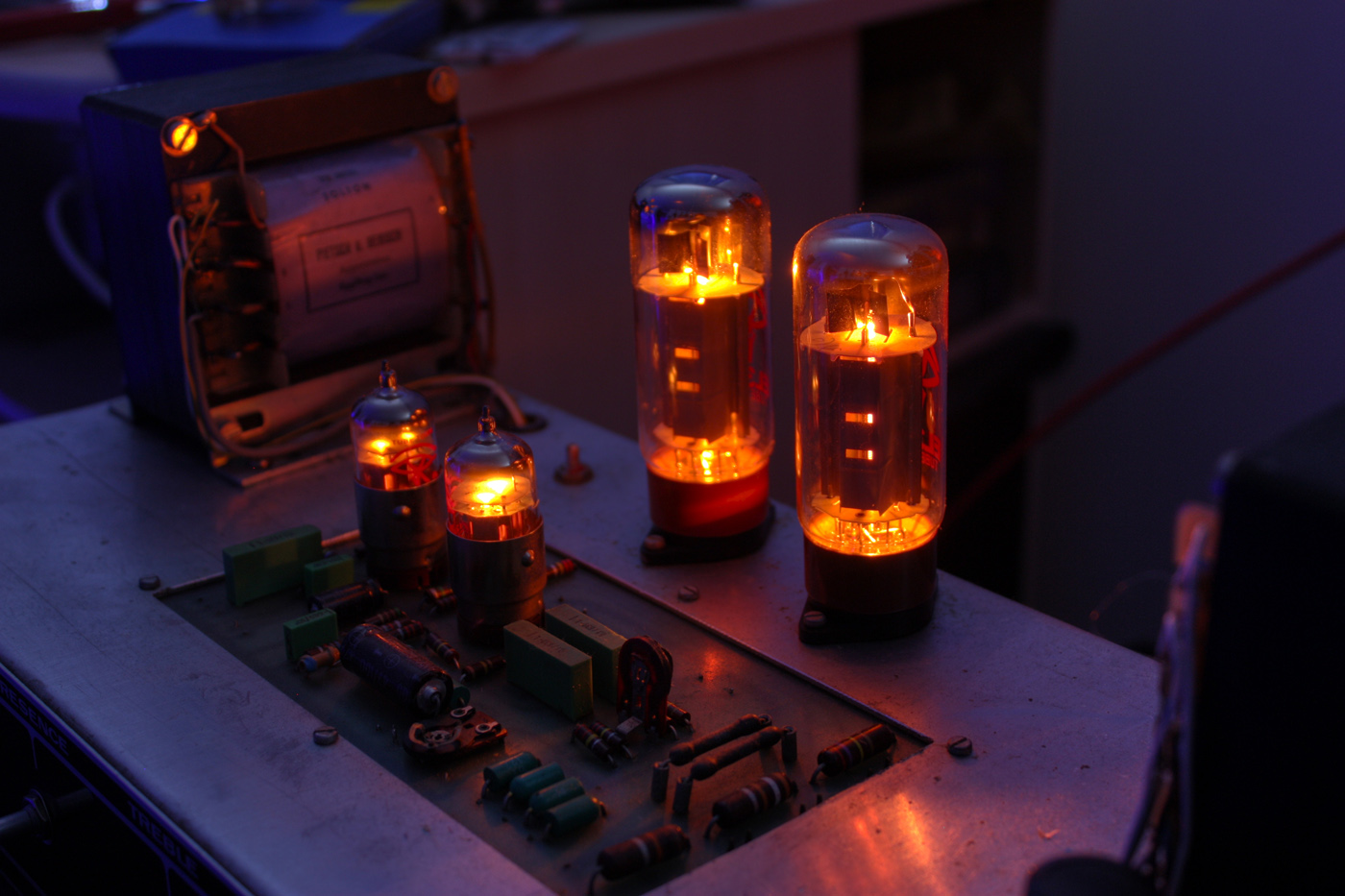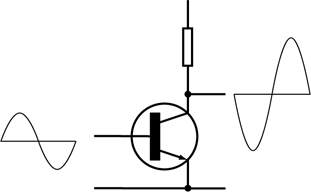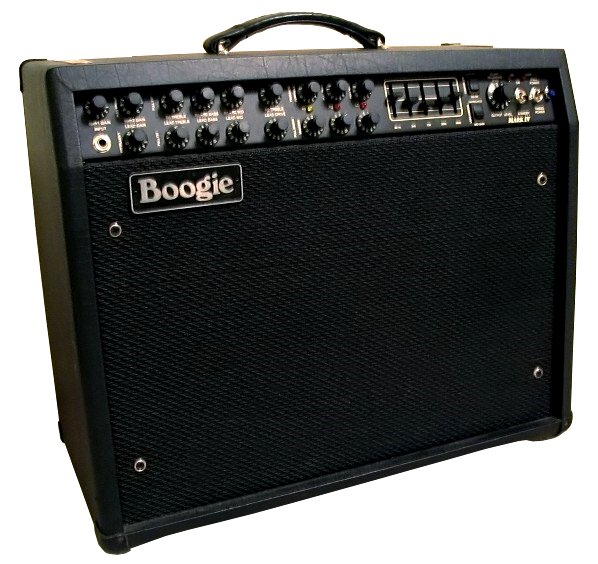|
KT66
KT66 is the designator for a beam power tube introduced by Marconi-Osram Valve Co. Ltd. (M-OV) of Britain in 1937 and marketed for application as a power amplifier for audio frequencies and driver for radio frequencies.Editors "The New Valves" ''Wireless World'', August 20th 1937, p. 178General Electric Co., Ltd."Osram Valves" ''Television and Short-Wave World'', Sept. 1939, p. 524 The KT66 is a beam tetrode that utilizes partially collimated electron beams to form a low potential space charge region between the anode and screen grid to return anode secondary emission electrons to the anode and offers significant performance improvements over comparable power pentodes.Dreyer, J. F. Jr."The Beam Power Output Tube" ''Electronics'', Vol. 9, No. 4, April 1936, pp. 18 - 21, 35 In the 21st century, the KT66 is manufactured and used in some high fidelity audio amplifiers and musical instrument amplifiers. Overview Although the RCA 6L6 of 1936 (the result of a license agreement between ... [...More Info...] [...Related Items...] OR: [Wikipedia] [Google] [Baidu] |
EL34
The EL34 is a thermionic vacuum tube of the power pentode type. The EL34 was introduced in 1955 by Mullard, who were owned by Philips. The EL34 has an octal base (indicated by the '3' in the part number) and is found mainly in the final output stages of audio amplification circuits; it was also designed to be suitable as a series regulator by virtue of its high permissible voltage between heater and cathode and other parameters. The American RETMA tube designation number for this tube is 6CA7. The USSR analog was 6P27S (Cyrillic: 6П27C). Specifications In common with all 'E' prefix tubes, using the Mullard–Philips tube designation, the EL34 has a heater voltage of 6.3 V. According to the data sheets found in old vacuum tube reference manuals, a pair of EL34s with 800 V plate voltage can produce 90 watts output in class AB1 in push–pull configuration. However, this configuration is rarely found. One application of this type was in "Australian Sound" public address ampli ... [...More Info...] [...Related Items...] OR: [Wikipedia] [Google] [Baidu] |
Beam Tetrode
A beam tetrode, sometimes called a beam power tube, is a type of vacuum tube or thermionic valve that has two grids and forms the electron stream from the cathode into multiple partially collimated beams to produce a low potential space charge region between the anode and screen grid to return anode secondary emission electrons to the anode when the anode potential is less than that of the screen grid.Winfield G. Wagener, (May 1948"500-Mc. Transmitting Tetrode Design Considerations" ''Proceedings of the I.R.E.'', p. 612. Retrieved 10 June 2021 Beam tetrodes are usually used for power amplification, from audio frequency to radio frequency. The beam tetrode produces greater output power than a triode or pentode with the same anode supply voltage. The first beam tetrode marketed was the Marconi N40, introduced in 1935.Editors, (Feb. 1935"New Output Tetrode" ''Electronics'', vol. 8 no.2, p. 65. Retrieved 10 June 2021K. R. Thrower, (2009) ''British Radio Valves The Classic Years: ... [...More Info...] [...Related Items...] OR: [Wikipedia] [Google] [Baidu] |
KT88
The KT88 is a beam tetrode/kinkless tetrode (hence "KT") vacuum tube for audio amplification. Features The KT88 fits a standard eight-pin octal socket and has similar pinout and applications as the 6L6 and EL34. Specifically designed for audio amplification, the KT88 has higher plate power and voltage ratings than the American 6550. It is one of the largest tubes in its class and can handle significantly higher plate voltages than similar tubes, up to 800 volts. A KT88 push-pull pair in class AB1 fixed bias is capable of 100 watts of output with 2.5% total harmonic distortion or up to about 50W at low distortion in hi-fi applications. The transmitting tubes TT21 and TT22 have almost identical transfer characteristics to KT88 but a different pinout, and by virtue of their anode being connected to the top cap have a higher plate voltage rating (1.25 kilovolt) and a higher power output capability of 200 watts in class AB1 push–pull. The screen grid is sometimes tied to the anod ... [...More Info...] [...Related Items...] OR: [Wikipedia] [Google] [Baidu] |
Vacuum Tube
A vacuum tube, electron tube, valve (British usage), or tube (North America), is a device that controls electric current flow in a high vacuum between electrodes to which an electric voltage, potential difference has been applied. The type known as a thermionic tube or thermionic valve utilizes thermionic emission of electrons from a hot cathode for fundamental electronic functions such as signal amplifier, amplification and current rectifier, rectification. Non-thermionic types such as a vacuum phototube, however, achieve electron emission through the photoelectric effect, and are used for such purposes as the detection of light intensities. In both types, the electrons are accelerated from the cathode to the anode by the electric field in the tube. The simplest vacuum tube, the diode (i.e. Fleming valve), invented in 1904 by John Ambrose Fleming, contains only a heated electron-emitting cathode and an anode. Electrons can only flow in one direction through the device—fro ... [...More Info...] [...Related Items...] OR: [Wikipedia] [Google] [Baidu] |
Vacuum Tubes
A vacuum tube, electron tube, valve (British usage), or tube (North America), is a device that controls electric current flow in a high vacuum between electrodes to which an electric potential difference has been applied. The type known as a thermionic tube or thermionic valve utilizes thermionic emission of electrons from a hot cathode for fundamental electronic functions such as signal amplification and current rectification. Non-thermionic types such as a vacuum phototube, however, achieve electron emission through the photoelectric effect, and are used for such purposes as the detection of light intensities. In both types, the electrons are accelerated from the cathode to the anode by the electric field in the tube. The simplest vacuum tube, the diode (i.e. Fleming valve), invented in 1904 by John Ambrose Fleming, contains only a heated electron-emitting cathode and an anode. Electrons can only flow in one direction through the device—from the cathode to the ... [...More Info...] [...Related Items...] OR: [Wikipedia] [Google] [Baidu] |
JJ Electronic
JJ Electronic, s.r.o is a Slovak electronic component manufacturer, and one of the world's remaining producers of vacuum tubes. It is based in Čadca, in the Kysuce region of Slovakia. Most of its products are audio receiving tubes, mainly used for guitar and hi-fi amplifiers. In technical terms, JJ produces triodes, beam tetrodes and power pentodes. Double diode vacuum tubes for full wave AC-to-DC rectifiers are also produced. JJ also produces electrolytic capacitors for higher-voltage purposes, generally for use in audio amplifiers. JJ also manufactures its own line of high-end audio amplifiers and guitar amplifiers. In 2015, the company sales amounted to EUR 8.5 million and net income came to EUR 3.8 million. Most production is exported to the United States. History Before 1989, Tesla was the main Czechoslovak producer of electron tubes. While Tesla vacuum tubes were exported all over the world, and were known for their quality, the company did not survive the change of e ... [...More Info...] [...Related Items...] OR: [Wikipedia] [Google] [Baidu] |
Class-A Amplifier
In electronics, power amplifier classes are letter symbols applied to different power amplifier types. The class gives a broad indication of an amplifier's characteristics and performance. The classes are related to the time period that the active amplifier device is passing current, expressed as a fraction of the period of a signal waveform applied to the input. A class A amplifier is conducting through all the period of the signal; Class B only for one-half the input period, class C for much less than half the input period. A Class D amplifier operates its output device in a switching manner; the fraction of the time that the device is conducting is adjusted so a pulse-width modulation output is obtained from the stage. Additional letter classes are defined for special-purpose amplifiers, with additional active elements or particular power supply improvements; sometimes a new letter symbol is used by a manufacturer to promote its proprietary design. Power amplifier classes Pow ... [...More Info...] [...Related Items...] OR: [Wikipedia] [Google] [Baidu] |
Guitar Amp
A guitar amplifier (or amp) is an electronic device or system that strengthens the electrical signal from a pickup on an electric guitar, bass guitar, or acoustic guitar so that it can produce sound through one or more loudspeakers, which are typically housed in a wooden cabinet. A guitar amplifier may be a standalone wood or metal cabinet that contains only the power amplifier (and preamplifier) circuits, requiring the use of a separate speaker cabinet–or it may be a "combo" amplifier, which contains both the amplifier and one or more speakers in a wooden cabinet. There is a wide range of sizes and power ratings for guitar amplifiers, from small, lightweight "practice amplifiers" with a single 6-inch speaker and a 10-watt amp to heavy combo amps with four 10-inch or four 12-inch speakers and a 100-watt amplifier, which are loud enough to use in a nightclub or bar performance. Guitar amplifiers can also modify an instrument's tone by emphasizing or de-emphasizing certa ... [...More Info...] [...Related Items...] OR: [Wikipedia] [Google] [Baidu] |
Proceedings Of The IRE
The ''Proceedings of the IEEE'' is a monthly peer-reviewed scientific journal published by the Institute of Electrical and Electronics Engineers (IEEE). The journal focuses on electrical engineering and computer science. According to the ''Journal Citation Reports'', the journal has a 2017 impact factor of 9.107, ranking it sixth in the category "Engineering, Electrical & Electronic." In 2018, it became fifth with an enhanced impact factor of 10.694. History of the Proceedings The journal was established in 1909, known as the ''Proceedings of the Wireless Institute''. Six issues were published under this banner by Greenleaf Pickard and Alfred Goldsmith. Then in 1911, a merger between the Wireless Institute (New York) and the Society of Wireless Telegraph Engineers (Boston) resulted in a society named the Institute of Radio Engineers (IRE). In January 1913 newly formed IRE published the first issue of the ''Proceedings of the IRE''. Later, a 1000-page special issue commemorate ... [...More Info...] [...Related Items...] OR: [Wikipedia] [Google] [Baidu] |
Otto H
Otto is a masculine German given name and a surname. It originates as an Old High German short form (variants ''Audo'', '' Odo'', '' Udo'') of Germanic names beginning in ''aud-'', an element meaning "wealth, prosperity". The name is recorded from the 7th century ( Odo, son of Uro, courtier of Sigebert III). It was the name of three 10th-century German kings, the first of whom was Otto I the Great, the first Holy Roman Emperor, founder of the Ottonian dynasty. The Gothic form of the prefix was ''auda-'' (as in e.g. '' Audaþius''), the Anglo-Saxon form was ''ead-'' (as in e.g. '' Eadmund''), and the Old Norse form was '' auð-''. The given name Otis arose from an English surname, which was in turn derived from ''Ode'', a variant form of ''Odo, Otto''. Due to Otto von Bismarck, the given name ''Otto'' was strongly associated with the German Empire in the later 19th century. It was comparatively frequently given in the United States (presumably in German American families ... [...More Info...] [...Related Items...] OR: [Wikipedia] [Google] [Baidu] |
807 (vacuum Tube)
__NOTOC__ Year 807 (Roman numerals, DCCCVII) was a common year starting on Friday (link will display the full calendar) of the Julian calendar. Events By place Abbasid Empire and Byzantine Empire * Emperor Nikephoros I is forced to sue for peace, on condition of paying 50,000 ''nomismata'' to Caliph Harun ar-Rashid, Harun al-Rashid, and agrees to a yearly tribute. Nikephoros promises not to rebuild the dismantled forts. Rashid recalls his forces from various sieges, and evacuates Byzantine Empire under the Nikephorian dynasty, Byzantine territory.. * An Abbasid fleet under Humayd ibn Ma'yuf al-Hajuri raids the Peloponnese, Rhodes and Myra. Europe * Al-Andalus (modern Spain): An uprising occurs in the city of Mérida, Spain, Mérida against the Umayyad Emirate of Córdoba. * Siege of Patras (805 or 807), Siege of Patras: This marks the end of independent rule by the South Slavs in the Peloponnese (or 805). Britain * The Vikings land on the Cornwall, Cornish coast, ... [...More Info...] [...Related Items...] OR: [Wikipedia] [Google] [Baidu] |


